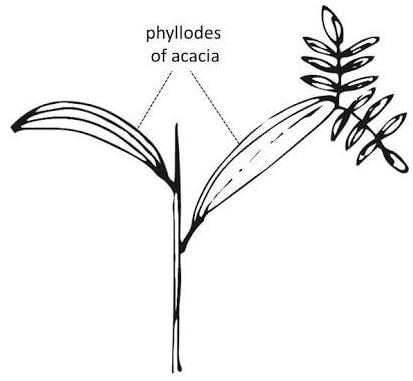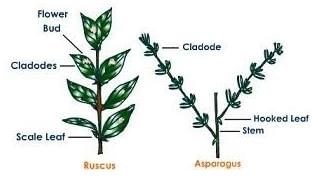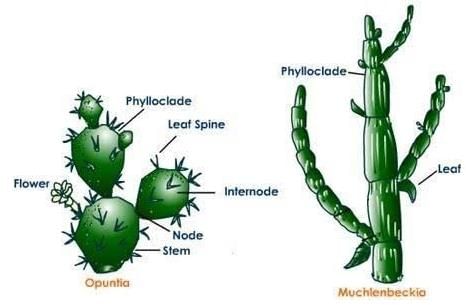Class 12 Exam > Class 12 Questions > difference between phyllodes, cladodes nd phy...
Start Learning for Free
difference between phyllodes, cladodes nd phylloclades.........???
Verified Answer
difference between phyllodes, cladodes nd phylloclades.........???
Phyllode: It is the petiole of the leaf, which becomes flattened in a vertical plane and takes up the appearance of a leaf blade. Petioles of such kind, are called phyllode. In these cases, the leaf lamina does not develop at all ( Acacia moniliformis of Fabaceae ) or falls off at an early stage of development ( A. recurva of Fabaceae ). It decreases the rate of transpiration.

Cladode: The leaf — like branches (metamorphosed), consisting of one internode are called cladode. They develop in the axil of minute scale leaves and serve the function of foliage leaves i.e., photosynthesis (e.g. Asparagus racemosus of Liliaceae ).

Phylloclade / Cladophyll: It is the flat leaf-like metamorphosed stem, consisting of many nodes and internodes and function as leaf. The original leaves may fall off or become very small or modified into spines (thus reduces the rate of transpiration). Sometimes,it acts as an organ of water storage. e.g. Prickly pear, Opuntia dillenii of Cactaceae.

 This question is part of UPSC exam. View all Class 12 courses
This question is part of UPSC exam. View all Class 12 courses
Most Upvoted Answer
difference between phyllodes, cladodes nd phylloclades.........???
Phyllodes, Cladodes, and Phylloclades: Explained
Phyllodes, cladodes, and phylloclades are all specialized leaf structures found in certain plants. While they may appear similar, there are distinct differences between them in terms of their origin, structure, and function.
1. Phyllodes:
Phyllodes are modified leaves that have transformed into flattened, blade-like structures. They are commonly found in plants belonging to the Acacia genus, such as Acacia longifolia and Acacia melanoxylon. Phyllodes lack a petiole (leaf stalk) and typically have a prominent midrib running along their length. Unlike typical leaves, phyllodes often persist for longer periods, sometimes even for several years. They serve as photosynthetic organs, capable of producing food for the plant.
2. Cladodes:
Cladodes are flattened stems that resemble and function as leaves. They are typically found in cacti, such as Opuntia and Schlumbergera. Cladodes may arise from the axils of reduced leaves or directly from the stem. They often have reduced or absent internodes and can perform photosynthesis. Cladodes are adapted to arid environments and help plants reduce water loss by minimizing the surface area exposed to the surrounding environment.
3. Phylloclades:
Phylloclades are flattened stems that resemble and function as leaves, similar to cladodes. However, unlike cladodes, phylloclades arise directly from the stem and lack axillary buds. They are commonly found in succulent plants like Euphorbia and Rhipsalis. Phylloclades have a higher water storage capacity than regular leaves, enabling the plants to survive in arid conditions. They also possess specialized structures called areoles, from which spines or flowers may arise.
Summary of Differences:
Origin:
- Phyllodes: Modified leaves.
- Cladodes: Flattened stems.
- Phylloclades: Flattened stems.
Structure:
- Phyllodes: Blade-like, lack petiole, often have a midrib.
- Cladodes: Flattened, may have reduced internodes.
- Phylloclades: Flattened, lack axillary buds, may have areoles.
Function:
- Phyllodes: Photosynthetic organs.
- Cladodes: Photosynthetic organs, reduce water loss.
- Phylloclades: Photosynthetic organs, water storage capacity.
Overall, while phyllodes, cladodes, and phylloclades share similarities in their leaf-like appearance and photosynthetic function, their origins, structures, and specific adaptations differ. These specialized leaf structures have evolved to help plants thrive in various environments, demonstrating the remarkable diversity and adaptability of plant species.
Phyllodes, cladodes, and phylloclades are all specialized leaf structures found in certain plants. While they may appear similar, there are distinct differences between them in terms of their origin, structure, and function.
1. Phyllodes:
Phyllodes are modified leaves that have transformed into flattened, blade-like structures. They are commonly found in plants belonging to the Acacia genus, such as Acacia longifolia and Acacia melanoxylon. Phyllodes lack a petiole (leaf stalk) and typically have a prominent midrib running along their length. Unlike typical leaves, phyllodes often persist for longer periods, sometimes even for several years. They serve as photosynthetic organs, capable of producing food for the plant.
2. Cladodes:
Cladodes are flattened stems that resemble and function as leaves. They are typically found in cacti, such as Opuntia and Schlumbergera. Cladodes may arise from the axils of reduced leaves or directly from the stem. They often have reduced or absent internodes and can perform photosynthesis. Cladodes are adapted to arid environments and help plants reduce water loss by minimizing the surface area exposed to the surrounding environment.
3. Phylloclades:
Phylloclades are flattened stems that resemble and function as leaves, similar to cladodes. However, unlike cladodes, phylloclades arise directly from the stem and lack axillary buds. They are commonly found in succulent plants like Euphorbia and Rhipsalis. Phylloclades have a higher water storage capacity than regular leaves, enabling the plants to survive in arid conditions. They also possess specialized structures called areoles, from which spines or flowers may arise.
Summary of Differences:
Origin:
- Phyllodes: Modified leaves.
- Cladodes: Flattened stems.
- Phylloclades: Flattened stems.
Structure:
- Phyllodes: Blade-like, lack petiole, often have a midrib.
- Cladodes: Flattened, may have reduced internodes.
- Phylloclades: Flattened, lack axillary buds, may have areoles.
Function:
- Phyllodes: Photosynthetic organs.
- Cladodes: Photosynthetic organs, reduce water loss.
- Phylloclades: Photosynthetic organs, water storage capacity.
Overall, while phyllodes, cladodes, and phylloclades share similarities in their leaf-like appearance and photosynthetic function, their origins, structures, and specific adaptations differ. These specialized leaf structures have evolved to help plants thrive in various environments, demonstrating the remarkable diversity and adaptability of plant species.

|
Explore Courses for Class 12 exam
|

|
Similar Class 12 Doubts
difference between phyllodes, cladodes nd phylloclades.........???
Question Description
difference between phyllodes, cladodes nd phylloclades.........??? for Class 12 2025 is part of Class 12 preparation. The Question and answers have been prepared according to the Class 12 exam syllabus. Information about difference between phyllodes, cladodes nd phylloclades.........??? covers all topics & solutions for Class 12 2025 Exam. Find important definitions, questions, meanings, examples, exercises and tests below for difference between phyllodes, cladodes nd phylloclades.........???.
difference between phyllodes, cladodes nd phylloclades.........??? for Class 12 2025 is part of Class 12 preparation. The Question and answers have been prepared according to the Class 12 exam syllabus. Information about difference between phyllodes, cladodes nd phylloclades.........??? covers all topics & solutions for Class 12 2025 Exam. Find important definitions, questions, meanings, examples, exercises and tests below for difference between phyllodes, cladodes nd phylloclades.........???.
Solutions for difference between phyllodes, cladodes nd phylloclades.........??? in English & in Hindi are available as part of our courses for Class 12.
Download more important topics, notes, lectures and mock test series for Class 12 Exam by signing up for free.
Here you can find the meaning of difference between phyllodes, cladodes nd phylloclades.........??? defined & explained in the simplest way possible. Besides giving the explanation of
difference between phyllodes, cladodes nd phylloclades.........???, a detailed solution for difference between phyllodes, cladodes nd phylloclades.........??? has been provided alongside types of difference between phyllodes, cladodes nd phylloclades.........??? theory, EduRev gives you an
ample number of questions to practice difference between phyllodes, cladodes nd phylloclades.........??? tests, examples and also practice Class 12 tests.

|
Explore Courses for Class 12 exam
|

|
Signup to solve all Doubts
Signup to see your scores go up within 7 days! Learn & Practice with 1000+ FREE Notes, Videos & Tests.





















